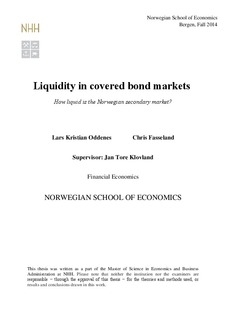Liquidity in covered bond markets : How liquid is the Norwegian secondary market?
Master thesis
Permanent lenke
http://hdl.handle.net/11250/276132Utgivelsesdato
2014Metadata
Vis full innførselSamlinger
Sammendrag
In this paper, we study the liquidity in the Norwegian secondary covered bond market, in
comparison to other Scandinavian covered and government bond markets.
We have gathered
data on trades and bonds in the markets from market participants
and
Financial S
upervisory
Authorities in the relevant countries, a process that can be characterized as challenging and
time consuming.
We discuss how new regulations
,
the reversal of the Government Swap
Agreement and the introduction of the Norwegian Covered Bonds Bench
mark has affected
liquidity.
Further, we investigate any differences in liquidity
with
in the Norwegian covered
bond market.
The research is conducted by implementing different liquidity measures that
together
allow for
thorough research of liquidity in the
markets we focus on
.
Overall, we find that
the liquidity in the Norwegian secondary covered bond market is neither
higher nor lower than the liquidity in the comparable markets
, even if there
are important
differences between some markets
.
Looking at dif
ferent groups of bonds in the Norwegian
covered bond market, we conclude that the
larger
bonds included in the Covered Bond
Benchmark have the highest liquidity.
Over the last years, the liquidity in the Norwegian
covered bond market has improved considerably along with the growth of the market. From
an unstable period with few bonds in the market in 2007 and 2008, all measures point at
higher liquidity from 2010/
2011 in more stable market conditions. We have not been able to
prove what part new regul
ations and the reversal of the swap a
greement
have
played in the
development, but we have some evidence for higher liquidity due to the implementation of
the Covered B
ond Benchmark.
